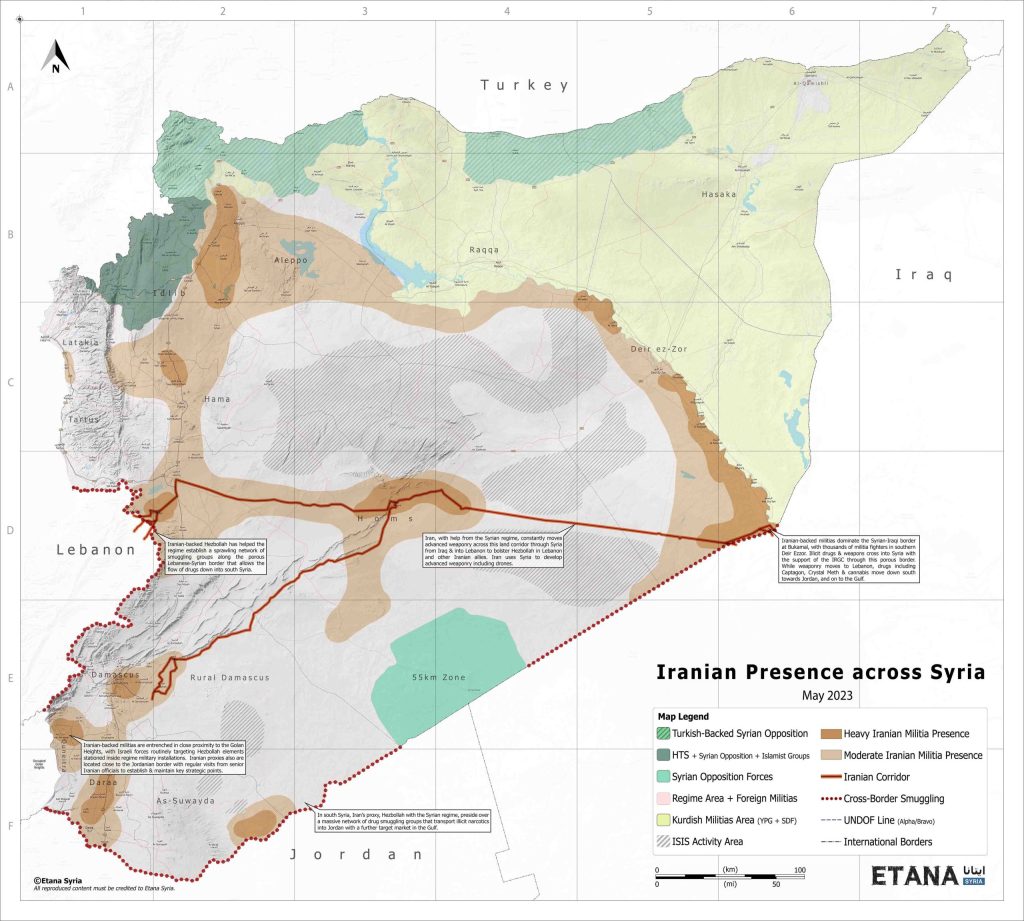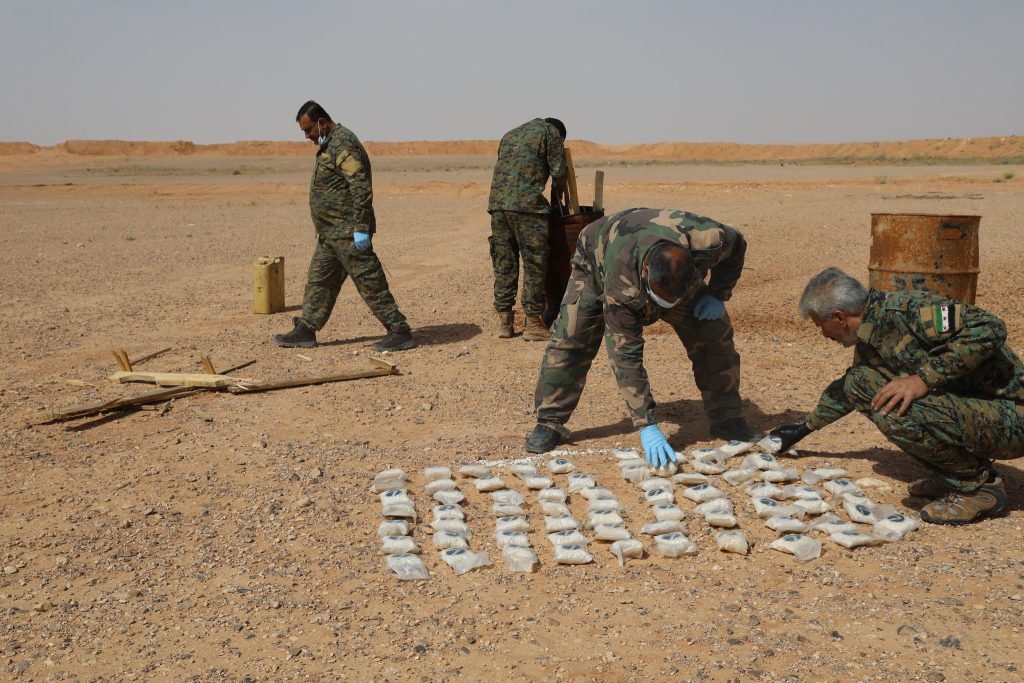12-years since its suspension, the Assad regime is now returning to the Arab League. Up against the very real and interwoven threats of Iran, ISIS, and the Damascus-backed narcotics trade, Arab states are betting that they can bring stability to Syria—and the region—by working directly with the regime. Yet each attempt to engage with Damascus has largely failed, demonstrating that the regime is either unwilling, or unable, to act as a reliable partner.
Over 12 years since the start of the Syrian uprising, more than one third of the country’s territory remains outside of Assad’s control. The areas the regime does control are littered with Iranian forces who facilitate the flow of drugs and weapons through the country. It is within this maelstrom of insecurity that ISIS has been able to maintain areas of influence, in multiple pockets across the country. The regime is not only unable to remedy these concerns, it is also unwilling to. These overlapping threats–Iran, the illicit narcotics trade, and ISIS–give Assad leverage with which to negotiate Syria’s return to the international political stage. The regime is leveraging problems of its own creating as diplomatic tools, presenting itself as a solution to problems that it created. Normalization is not an effective solution to the Syrian crisis, and the regime is not a reliable partner for pursuing stabilization and security.
Summary: Key Findings
- Iran is not leaving Syria: Tehran views its influence in Syria as vital to its wider ambitions across the region: normalization will not disentangle the two from each other.
- ISIS flourishes in regime-held areas: ISIS’ most active areas of influence are in regime-held territory, where the group is able to carry out violent attacks on armed groups and civilians.
- Cooperation will not cap Captagon: The regime and its allies have transformed Syria into a narco-state for their own gains. The regime is completely reliant on the multi-billion-dollar revenues from the regional transportation and sale of Captagon and cannot do without it.

Iran is not leaving Syria
Iran is deeply embedded in all sides of the Syrian regime’s operations, from military and security to policy, economy, and even humanitarian and social activities. Its influence on these plains spans Syria’s geography from east to west, north to south. In particular, Iran has carved out selective redoubts of influence and control within strategic geographic locations and various organs of the regime’s military-security apparatus, a strategy aimed at complimenting Iran’s broader regional ambitions of cementing its influence across the Levant. An example of its security and military policies in Syria that have regional goals are the westward weapons transfers and illicit economic activities. With Damascus’ consent, Iran, and Hezbollah have created a vast overland transportation and smuggling route for clandestinely transferring Hezbollah-bound missile systems and advanced weaponry from the Syrian-Iraqi border towards the Syrian-Lebanese border in the west, via remote desert areas of central Syria.
This is an operation that is run out of the core inner circle of the Syrian regime: advisers close to Bashar al-Assad coordinate through contacts with Iran and Hezbollah, while the 4th Division and Republican Guard facilitate shipments across the border into Lebanon. The 4th Division’s influence is disproportionate and wide-sweeping: its close ties with both Hezbollah and Iran allow it to facilitate the movement of narcotics from Lebanon through Syria and into Jordan and the Arab Gulf, while its control of sections of Syria’s private sector—such as the pharmaceutical sector—allowed it to establish dominance in the drug trade.
ISIS flourishes in regime-held areas
Today, the Assad regime controls just 64.6% of Syrian territory, and even in these areas its authority is consistently challenged by civilians and former opposition groups. The Assad regime has a long history of aiding and abetting jihadis in Syria for its own gains. Syria’s central and north-eastern Badia desert region is home to hundreds of hardened fighters, whose groups can move across desert areas with relative ease and conduct operations against the various conflict parties. The regime, Russia and Iran have failed to counter ISIS and will continue to fail since this is not their main priority in Syria. It is no coincidence that the only remaining pockets of ISIS influence remain in regime-held areas. The regime has proven itself to be an incapable counter-terrorism partner in this strategic area.
Nowhere is the regime’s fragile authority more evident than in south Syria, where multiple armed actors continue to compete for influence more than five years after the regime’s nominal return. Although a lesser-known theater for both the regime and ISIS, south Syria is also home to residual ISIS cells. Here, the regime has done little to limit the influence of the radical groups. In this area, an often-used tactic was to displace the issue of radical fighters rather than resolve it, allowing the regime to place the onus of counter-terrorism operations on rivals in competing zones of control. Damascus also actively utilizes ISIS cells for its own strategic ends–including against the former opposition in the south. The regime possesses tacit connections with ISIS cells that grants the regime a degree of influence over their operations. This allows the regime to maneuver ISIS cells against their enemies and use their presence as a justification to crack-down on civilian populations in south Syria.

Cooperation will not cap Captagon
The lucrative Captagon trade provides the Syrian regime with vital protection and economic lifeblood to sustain itself. Smuggling networks are run by the regime’s security apparatus. The regime and Hezbollah have crafted a massive regional drug network that utilizes Hezbollah-run production facilities in Lebanon and regime middlemen and local smugglers in south Syria, with narcotics ultimately reaching wealthy buyers in the Arab Gulf via Jordan.
In the months and weeks leading up to its readmission to the Arab League, the Assad regime indicated to concerned Arab states that it would cooperate to tackle the drug trade. But its actions since have been largely empty gestures: in an apparent concession to Jordan, last month the regime moved 20 prefabricated mobile bases to border areas in southeastern Daraa–an area with little recorded smuggling activity. In the same time period, more than 1,785 kilos of cannabis and Captagon pills arrived in southern Daraa and south-eastern Suwayda.
Normalization is not a solution
The Syrian regime is the driver and benefactor of Iranian expansionism, drug smuggling, and corruption. The chaos the regime perpetuates offers ISIS fertile ground to move and spread across the region. Pursuing renewed political relations with Damascus will not change these realities on the ground. The Assad regime is an agent of instability, not a solution for stability. Sustainable solutions to the deep-seated problems Syria faces can only come through a durable political solution and the implementation of in-depth reforms to the Syrian state.




